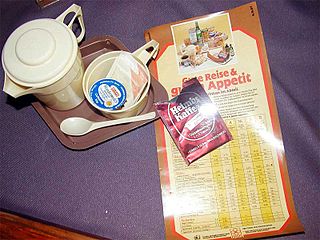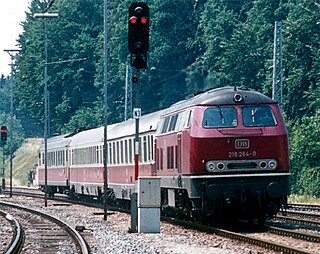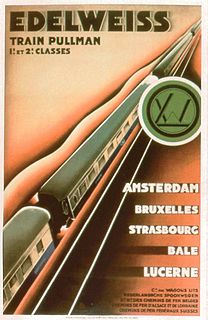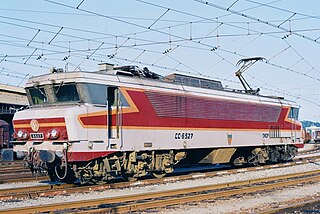 | |||||
| Overview | |||||
|---|---|---|---|---|---|
| Service type | Trans Europ Express (TEE) | ||||
| Status | Discontinued | ||||
| Locale | Germany France | ||||
| First service | 2 June 1980 | ||||
| Last service | 27 May 1983 | ||||
| Former operator(s) | Deutsche Bundesbahn (DB) SNCF | ||||
| Route | |||||
| Start | Dortmund Hbf | ||||
| Stops | 12 | ||||
| End | Strasbourg-Ville | ||||
| Service frequency | Daily, Monday to Friday | ||||
| Train number(s) | TEE 8, 9 | ||||
| On-board services | |||||
| Class(es) | First class only | ||||
| Catering facilities | Restaurant car | ||||
| Technical | |||||
| Track gauge | 1,435 mm (4 ft 8 1⁄2 in) | ||||
| Electrification | 15 kV AC, 16.7 Hz (Germany) | ||||
| |||||
The Albert Schweitzer was a short-lived express train that linked Dortmund Hbf in Dortmund, Germany, with Strasbourg-Ville in Strasbourg, France. Introduced in 1980, [1] it was operated by the Deutsche Bundesbahn (DB) and the SNCF.

Express trains are a form of rail service. Express trains make only a small number of stops, instead of stopping locally. In some cases, trains run express where there is overlapping local train service available, and run local at the tail ends of the line, where there is no supplemental local service. During overnight hours, or other times where it is practical, express trains may become local, but still running to where an express train would terminate.

Dortmund Hauptbahnhof is the main railway station in Dortmund, North Rhine-Westphalia, Germany. The station's origins lie in a joint station of the Köln-Mindener Eisenbahn and Bergisch-Märkische Eisenbahn which was built north of the city centre in 1847. That station was replaced by a new station, erected in 1910 at the current site. It featured raised embankments to allow a better flow of traffic. At the time of its opening, it was one of the largest stations in Germany. It was, however, destroyed in an Allied air raid on 6 October 1944.
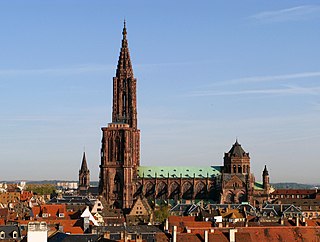
Strasbourg is the capital and largest city of the Grand Est region of France and is the official seat of the European Parliament. Located at the border with Germany in the historic region of Alsace, it is the capital of the Bas-Rhin department. In 2016, the city proper had 279,284 inhabitants and both the Eurométropole de Strasbourg and the Arrondissement of Strasbourg had 491,409 inhabitants. Strasbourg's metropolitan area had a population of 785,839 in 2015, making it the ninth largest metro area in France and home to 13% of the Grand Est region's inhabitants. The transnational Eurodistrict Strasbourg-Ortenau had a population of 915,000 inhabitants in 2014.
Contents
The train was named after Albert Schweitzer (1875–1965), a German and then French theologian, organist, philosopher, physician, and medical missionary, who was born in the province of Alsace-Lorraine and educated partly in Strasbourg.

Albert Schweitzer, OM was an Alsatian theologian, organist, writer, humanitarian, philosopher, and physician. A Lutheran, Schweitzer challenged both the secular view of Jesus as depicted by the historical-critical method current at this time, as well as the traditional Christian view. His contributions to the interpretation of Pauline Christianity concern the role of Paul's mysticism of "being in Christ" as primary and the doctrine of Justification by Faith as secondary.

Theology is the critical study of the nature of the divine. It is taught as an academic discipline, typically in universities and seminaries.

An organist is a musician who plays any type of organ. An organist may play solo organ works, play with an ensemble or orchestra, or accompany one or more singers or instrumental soloists. In addition, an organist may accompany congregational hymn-singing and play liturgical music.
The Albert Schweitzer was a first-class-only Trans Europ Express (TEE) and operated on Mondays to Fridays only. It was intended mainly to provide transport between Bonn, then the capital of West Germany, and the European Parliament in Strasbourg. It was discontinued in 1983. [2]
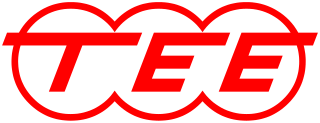
The Trans Europ Express, or Trans-Europe Express (TEE), is a former international first-class railway service in western and central Europe that was founded in 1957 and ceased in 1995. At the height of its operations, in 1974, the TEE network comprised 45 trains, connecting 130 different cities, from Spain in the west to Austria in the east, and from Denmark to Southern Italy.

The Federal City of Bonn is a city on the banks of the Rhine in the German state of North Rhine-Westphalia, with a population of over 300,000. About 24 km (15 mi) south-southeast of Cologne, Bonn is in the southernmost part of the Rhine-Ruhr region, Germany's largest metropolitan area, with over 11 million inhabitants.

The European Parliament (EP) is the only parliamentary institution of the European Union (EU) that is directly elected by EU citizens aged 18 or older. Together with the Council of the European Union, which should not be confused with the European Council and the Council of Europe, it exercises the legislative function of the EU. The Parliament is composed of 751 members (MEPs), that will become 705 starting from the 2019–2024 legislature, who represent the second-largest democratic electorate in the world and the largest trans-national democratic electorate in the world.

